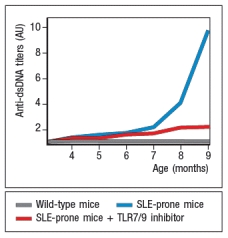A disease resembling systemic lupus erythematosis (SLE) can be induced in mice. A key characteristic of this disease is the production of autoantibodies with specificity for double-stranded DNA (dsDNA) , nucleosomes, and ribonucleotide-protein complexes (RNPs) . When these mice are treated with a small molecule TLR7 and TLR9 inhibitor, twice a week starting at 4 months of age, the data in Figure Q4) are obtained.  Figure Q4) In this system, the TLR7/TLR9 inhibitor:
Figure Q4) In this system, the TLR7/TLR9 inhibitor:
A) Prevents B cell activation by bacterial DNA from microbes in the environment
B) Prevents B cell activation by DNA from commensal microbes in the gut
C) Prevents B cell activation due to uptake of chromatin from apoptotic host cells
D) Prevents B cell activation by IgG present in immune complexes
E) Prevents B cell activation following low affinity antigens stimulating the B-cell receptor
Correct Answer:
Verified
Q10: AIRE is a transcriptional regulator that promotes
Q11: All autoreactive CD4 T cells are not
Q12: Rheumatoid arthritis is often classified as
Q13: Nearly 80% of patients with autoimmune
Q14: Treg cells that express FoxP3 are
Q16: Due to its multiple roles in promoting
Q17: Some early studies aimed at deciphering
Q18: A subset of patients with imbalances in
Q19: Systemic lupus erythematosis (SLE) is an autoimmune
Q20: A mouse model for type 1
Unlock this Answer For Free Now!
View this answer and more for free by performing one of the following actions

Scan the QR code to install the App and get 2 free unlocks

Unlock quizzes for free by uploading documents